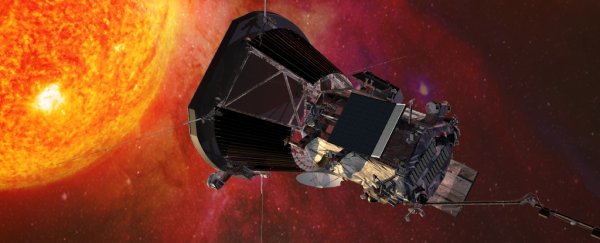This Wednesday, NASA will officially announce its intention to launch a probe that will dip inside the Sun's atmosphere, calling it the first ever mission to "touch the Sun".
The Solar Probe Plus mission will have to cope with temperatures and radiation unlike any other probe, but the data it will collect in the process will help astronomers predict solar storms and provide clues on some of the deepest mysteries surrounding our closest star.
In 1976, a 370-kilogram (815-pound) block of instruments called Helios 2 came within about 43 million kilometres (27 million miles) of the Sun's surface in its mission to study solar winds and cosmic rays.
Our world has since grown ever more dependent on a network of technology – both in orbit and on our planet's surface – that's vulnerable to a threat we barely understand.
Not only can our modern technology suffer enormous damage from extreme solar activity, humans who might one day live outside our atmosphere will also need protection from severe winds of charged particles and radiation.
In order to find ways to improve our understanding, NASA is going to get even more up close and personal with the Sun's corona than Helios 2, and blow its record out of the sky.
Due to be launched around August next year, the robust little probe will swing past Venus seven times over the course of seven years to fine-tune an orbit that will take it within 6 million kilometres (a little under 4 million miles) of the Sun's surface – or photosphere – in 24 elliptical loops.
That might not sound very close, but at just nine times the Sun's radius, it's still a rather daring move that will allow sensors to sweep close enough to trace the magnetic fields and catch a few solar particles without getting fried.
As it is, the probe will be forced to endure temperatures up to 1,400° Celsius (about 2,550° Fahrenheit) while keeping its payload at a comfy room temperature.
Not being content with sitting and waiting until Wednesday, we asked Brad Tucker from the Australian National University's Research School of Astronomy and Astrophysics to explain how NASA expects to pull off this feat.
"The biggest leap in technology of this mission is the heat shield," Tucker explained to ScienceAlert.
"The heat shield is an 11.5-centimetre-thick carbon composite shield, which can withstand temperatures of nearly 1,400 degrees Celsius. The use of carbon composite is really allowing us to do much more complicated things."
Carbon in the form of materials such as nanotubes and graphene have already revolutionised our ability to make probes light enough to launch and yet tough enough to endure extreme temperatures under some of the Solar System's more hostile conditions.
In addition to the heat shield, the US$1.5 billion Solar Probe Plus (SPP) will use an active water circulation system to help protect instruments that will measure the corona's electric and magnetic fields, electron temperatures, and plasma density.
And of course, there'll also be an imaging system to take a few holiday snaps while spending such quality time under the Sun.
"Understanding the activity of the Sun and predicting weather from it is crucial if we really want to have humans explore space more, including working and living on the Moon and Mars," says Tucker.
Getting a grip on how particles are whipped into high speeds will also give researchers a better idea on how objects move through space. Tucker pointed out that the Kepler Space Telescope is steered by solar winds.
"By understanding the solar wind in better detail, how it is accelerated namely, it will open up the possibility of using it to accelerate space craft like the one proposed in the Light Sail project," Tucker told ScienceAlert.
Another ongoing astronomical mystery in need of a few clues is the question of the corona's odd temperature.
The Sun's photosphere is a touch over 5,500 degrees Celsius (over 10,000 degrees Fahrenheit), yet this toasty temperature soars up to several million degrees as it turns into the corona.
While there are hypotheses as to why this radical heating occurs, more evidence could establish the cause.
If you're a big fan of solar astronomy, jump onto NASA TV on Wednesday, 3pm Greenwich Mean Time (11am Eastern Daylight Time; 1am Australian Eastern Standard Time) to hear for yourself what the researchers are planning.
